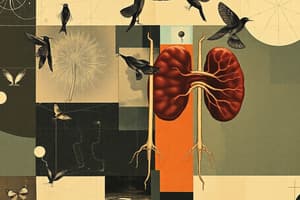Podcast
Questions and Answers
Which of the following best describes the primary function of coordination in living organisms?
Which of the following best describes the primary function of coordination in living organisms?
- Producing a cohesive response through integrated activities. (correct)
- Breaking down complex molecules for energy.
- Isolating individual organ functions.
- Filtering waste products from the blood.
Positive feedback mechanisms always maintain homeostasis by reversing changes in the body.
Positive feedback mechanisms always maintain homeostasis by reversing changes in the body.
False (B)
What is the fundamental difference in how plants and animals achieve coordination?
What is the fundamental difference in how plants and animals achieve coordination?
Plants use hormones and tropisms, while animals primarily use a nervous system.
In the nervous system, a(n) _________ is an automatic response to a stimulus, such as withdrawing a hand from a hot object.
In the nervous system, a(n) _________ is an automatic response to a stimulus, such as withdrawing a hand from a hot object.
Match the plant hormones with their primary function:
Match the plant hormones with their primary function:
Which component of the nervous system is responsible for processing information?
Which component of the nervous system is responsible for processing information?
What is the role of receptors in control systems?
What is the role of receptors in control systems?
Which of the following disorders is primarily associated with the endocrine system's inability to regulate blood sugar levels?
Which of the following disorders is primarily associated with the endocrine system's inability to regulate blood sugar levels?
Which of the following represents the correct flow of information in a typical neural pathway?
Which of the following represents the correct flow of information in a typical neural pathway?
Schwann cells are responsible for forming the myelin sheath around axons in the Central Nervous System (CNS).
Schwann cells are responsible for forming the myelin sheath around axons in the Central Nervous System (CNS).
What is the primary function of the Nodes of Ranvier in the context of neuronal signal transmission?
What is the primary function of the Nodes of Ranvier in the context of neuronal signal transmission?
The space between the presynaptic and postsynaptic neuron is known as the ______.
The space between the presynaptic and postsynaptic neuron is known as the ______.
Match the neuron component with its primary function:
Match the neuron component with its primary function:
In a reflex arc, which type of neuron is responsible for carrying the response signal from the central nervous system (CNS) to the effector?
In a reflex arc, which type of neuron is responsible for carrying the response signal from the central nervous system (CNS) to the effector?
Reflex arcs are slower than conscious actions because they involve more complex neural pathways.
Reflex arcs are slower than conscious actions because they involve more complex neural pathways.
What is the importance of reflex actions?
What is the importance of reflex actions?
Flashcards
Coordination
Coordination
Integration of bodily functions for a unified response.
Central Nervous System (CNS)
Central Nervous System (CNS)
Brain and spinal cord; the control center.
Peripheral Nervous System (PNS)
Peripheral Nervous System (PNS)
Nerves extending throughout the body; carries signals.
Neuron
Neuron
Signup and view all the flashcards
Reflex Action
Reflex Action
Signup and view all the flashcards
Endocrine System
Endocrine System
Signup and view all the flashcards
Homeostasis
Homeostasis
Signup and view all the flashcards
Tropism
Tropism
Signup and view all the flashcards
Coordination Centers
Coordination Centers
Signup and view all the flashcards
Effectors
Effectors
Signup and view all the flashcards
Cell Body (Soma)
Cell Body (Soma)
Signup and view all the flashcards
Dendrites
Dendrites
Signup and view all the flashcards
Myelin Sheath
Myelin Sheath
Signup and view all the flashcards
Reflex Arc
Reflex Arc
Signup and view all the flashcards
Receptor (Reflex Arc)
Receptor (Reflex Arc)
Signup and view all the flashcards
Synapse
Synapse
Signup and view all the flashcards
Study Notes
- Coordination and control are vital for living organisms to detect and respond to environmental stimuli, maintaining homeostasis and enabling interaction.
Coordination in Living Organisms
- Coordination integrates bodily functions and activities for a cohesive response.
- Coordination is achieved through the nervous and endocrine systems.
Nervous System
- The nervous system includes the Central Nervous System (CNS) and the Peripheral Nervous System (PNS).
- CNS includes the brain and spinal cord.
- PNS includes nerves extending throughout the body.
- The nervous system detects stimuli via sensory organs, processes information in the brain and spinal cord, and sends responses to effectors like muscles and glands.
- Neuron refers to the basic unit of the nervous system.
- Reflex Action refers to an automatic response to a stimulus.
Endocrine System
- The endocrine system includes glands like the pituitary, thyroid, and pancreas, which secrete hormones.
- Regulates long-term processes such as growth, reproduction, and metabolism.
- Hormones travel through the blood to target organs.
- Insulin regulates blood sugar levels.
- Adrenaline prepares the body for "fight or flight".
Control Mechanisms
- Control mechanisms maintain balance and ensure appropriate responses to stimuli via homeostasis.
Homeostasis
- Homeostasis refers to the process by which organisms maintain a stable internal environment.
- Examples of homeostasis include temperature and blood sugar level regulation.
- Negative Feedback reverses a change to maintain balance; an example is sweating to cool the body.
- Positive Feedback enhances a change; an example is blood clotting during injury.
Coordination in Plants
- Plants respond to stimuli using tropisms and plant hormones.
- Tropisms are growth movements in response to stimuli such as phototropism and gravitropism.
- Auxins promote cell elongation.
- Cytokinins promote cell division.
- Gibberellins stimulate growth and seed germination.
Disorders of Coordination and Control
- Parkinson's Disease is a nervous system disorder causing tremors and movement difficulties.
- Diabetes Mellitus is an endocrine disorder from insufficient insulin production or action.
Relationship Among the Receptor, CNS, and Effector
- Control systems include receptors that detect stimuli, coordination centers like the brain, spinal cord, or pancreas, which process information and effectors, which bring about responses such as muscle contractions or hormone release.
- Flow of information: Stimulus goes to Receptor, then Coordinator, then Effector, and finally a Response.
Parts of a Neuron
- Cell Body (Soma) contains the nucleus and processes signals from dendrites.
- Dendrites receive signals from other neurons or receptors.
- Axon conducts electrical impulses away from the cell body.
- Myelin Sheath insulates the axon and increases signal transmission speed.
- Nodes of Ranvier are gaps in the myelin sheath that speed up impulse transmission.
- Axon Terminals release neurotransmitters to send signals across synapses.
- Nucleus controls neuron function and protein production.
- Synapse is the junction where neurons communicate via neurotransmitters.
- Schwann Cells form myelin sheath in the PNS.
- Cytoplasm supports organelles and metabolic activities.
Reflex Arc
- Reflex arc is the neural pathway involved in producing a quick, automatic response to protect the body from harm.
Components of a Reflex Arc
- Stimulus triggers the reflex.
- Receptor detects the stimulus.
- Sensory Neuron transmits the signal to the CNS.
- Interneuron (Relay Neuron) processes information in the CNS.
- Motor Neuron carries the response signal to the effector.
- Effector performs the response.
- Withdrawal Reflex is pulling a hand away from a hot object.
- Knee-Jerk Reflex is the sudden leg movement when the tendon below the kneecap is tapped.
- Pupil Reflex is the constriction of pupils in bright light.
Importance of Reflex Arcs
- Reflex arcs provide protection through quick responses, are efficient by being faster than conscious actions, and aid survival by maintaining homeostasis.
Synapse and Signal Transmission
- A synapse is the junction between neurons or between a neuron and an effector cell that enables the transfer of signals.
- Presynaptic Neuron sends the signal.
- Synaptic Cleft is the gap between neurons.
- Postsynaptic Neuron receives the signal.
Transmission of an Impulse Across a Synapse
- Arrival of Action Potential occurs at the axon terminal.
- Calcium Ion Influx goes into the axon terminal.
- Neurotransmitters are released into the synaptic cleft.
- Neurotransmitters bind to receptors on the postsynaptic neuron.
- Postsynaptic Potential is generated.
- The signal propagates or is inhibited.
- The signal terminates by enzymatic breakdown or reuptake.
- Synapses allow unidirectional signal transmission.
- Chemical synapses use neurotransmitters, while electrical synapses use direct current flow.
- Synaptic transmission is vital for learning, memory, and reflexes.
Summary
- The nervous system provides fast responses, and the endocrine system regulates long-term functions; both systems maintain homeostasis.
- Reflex arcs allow rapid responses to stimuli without conscious control.
- Synapses facilitate communication between neurons.
Studying That Suits You
Use AI to generate personalized quizzes and flashcards to suit your learning preferences.
Related Documents
Description
Explore coordination and control in living organisms, focusing on the nervous and endocrine systems. Understand how these systems enable organisms to respond to stimuli, maintain homeostasis, and interact with their environment. Key concepts include the central and peripheral nervous systems, neurons, reflex actions, and the roles of various endocrine glands.




